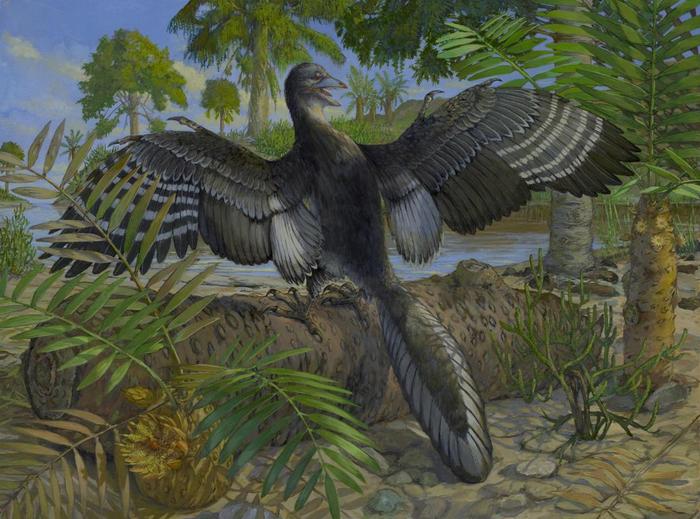Acquired by Chicago’s Field Museum in 2022, the Chicago Archaeopteryx stands out as the smallest known specimen within its genus, comparable in size to a modern pigeon. What sets this fossil apart is its remarkable three-dimensional preservation of skeletal elements, alongside a suite of rare soft tissue remnants including skin, toe pads, and feathers. This nearly complete specimen allows an exploration into fine details seldom preserved in fossils, opening new pathways for interpreting the physical adaptations and ecological lifestyle of this pivotal creature in the dinosaur-bird transition.
Beyond cranial anatomy, the Chicago Archaeopteryx offers an unprecedented view into soft tissue structures. Notably, the morphology of the toe pads is strikingly similar to those found in modern ground-foraging birds. This evidence suggests that Archaeopteryx was not exclusively arboreal but possessed adaptations supporting terrestrial locomotion without utilizing raptorial grasping. Such ecological flexibility indicates a mixed lifestyle where the animal may have navigated both ground and arboreal environments, providing a more nuanced picture of its behavioral ecology than previously hypothesized.
The integration of three-dimensional scanning and digital reconstruction technologies marks a significant leap forward in paleontological methodology. Traditionally hampered by the fragility of fossils and two-dimensional limitations, these technological tools enable precise visualization and analysis of both skeletal and soft tissue anatomy without damaging irreplaceable specimens. The Chicago Archaeopteryx exemplifies this new frontier, laying the groundwork for more comprehensive biomechanical studies and functional assessments of fossil bird skulls, which are essential for understanding feeding strategies and sensory capabilities.
Moreover, soft tissue preservation in this specimen provides invaluable insights into the integumentary system of early birds. The soft tissue remnants offer clues about feather arrangement, skin texture, and muscle attachments that inform interpretations about thermoregulation, display behaviors, and flight mechanics. These biological markers contribute to a more integrated comprehension of Archaeopteryx biology beyond bones, which were previously the primary source of anatomical information.
In addition to paleontological significance, the specimen holds cultural and educational importance due to its high visibility and accessibility at the Field Museum. Displaying this fossil with state-of-the-art digital models provides the public and scientific communities alike an unprecedented window into the early history of birds. Educational initiatives leveraging this discovery are poised to inspire interest in evolutionary biology, highlighting the dynamic interplay between ancient life and modern technology.
The findings were facilitated by collaborative international efforts and funded by the National Natural Science Foundation of China, demonstrating the crucial role of global partnerships in advancing paleontological knowledge. The seamless cooperation between Chinese and American institutions underscores the shared commitment to uncovering Earth’s deep biological past through scientific innovation.
Finally, this discovery not only refines the phylogenetic position of Archaeopteryx but also challenges existing paradigms about evolutionary transitions. The integration of skeletal and soft tissue data contributes to a holistic understanding of this critical genus and opens avenues for exploring evolutionary mechanisms in other extinct lineages. As palaeontology embraces technological advancements, fossils like the Chicago Archaeopteryx continue to rewrite the evolutionary story of life on Earth with greater clarity and detail than ever before.
Subject of Research: Evolutionary biology, early bird evolution, Archaeopteryx paleontology
Article Title: Newly Discovered Chicago Archaeopteryx Specimen Illuminates Evolutionary Transition from Dinosaurs to Birds
News Publication Date: May 2025
Web References: http://dx.doi.org/10.1038/s41586-025-08912-4
References: HU Han et al., Nature, 2025
Image Credits: Image by O’Connor et al., Nature
Keywords: Evolution, Paleontology, Archaeopteryx, Feathered Dinosaurs, Avian Flight Evolution, Fossil Discovery
Tags: advanced imaging techniques in paleontologyChicago Archaeopteryx discoverydinosaur-to-bird evolutionDr. HU Han paleontology contributionsDr. Jingmai O’Connor research achievementshigh-resolution CT scanning in fossil studiesintegration of technology in fossil researchinternational paleontological researchmorphological studies of Archaeopteryxpublication in Nature journal.significance of Archaeopteryx in evolutionary biologysoft tissue analysis in ancient fossils





